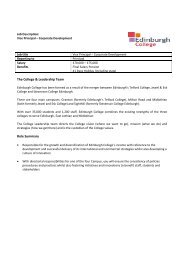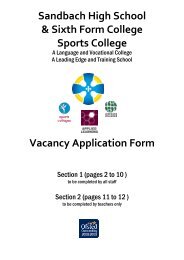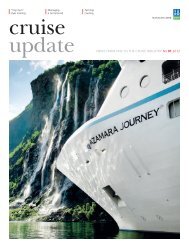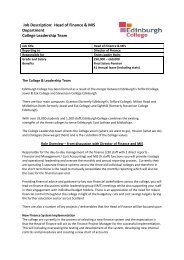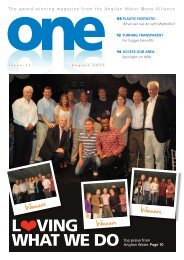Intertanko and <strong>the</strong> EEDIIntertanko and <strong>the</strong> EEDI:seeking a level playing fieldIntertanko fully supported IMO’s adoption of manda<strong>to</strong>ry measures <strong>to</strong> reduce <strong>the</strong>industry’s contribution <strong>to</strong> greenhouse gases (GHG) this summer. But with someissues yet <strong>to</strong> be settled, Intertanko insists that Energy Efficiency Design Index (EEDI)requirements should apply equally <strong>to</strong> all ships on <strong>the</strong> same effective date.Interview by Jan Koren and Alexander Wardwell›› Graham Westgarth, Chairman of IntertankoEEDI – reducing carbon emissions,one vessel at a timeThe EEDI applies <strong>to</strong> all vessels built after 2013. Bysome estimates, <strong>the</strong> measure will help remove 45<strong>to</strong> 50 million <strong>to</strong>nnes of CO2 <strong>from</strong> <strong>the</strong> atmosphereannually by 2<strong>02</strong>0, depending on <strong>the</strong> growthin world trade. For 2030, <strong>the</strong> reduction will bebetween 180 and 240 million <strong>to</strong>nnes annually since<strong>the</strong> introduction of <strong>the</strong> EEDI.Pho<strong>to</strong>: DNV/Nina E. RangøyThis summer, <strong>the</strong> IMO’s Marine ProtectionCommittee (MEPC) introducedmanda<strong>to</strong>ry measures <strong>to</strong> reduce GHG and<strong>the</strong>se measures have been adopted by <strong>the</strong>parties <strong>to</strong> Marpol. The amendments <strong>to</strong>Marpol Annex VI regulations on energyefficiency include <strong>the</strong> EEDI, which applies<strong>to</strong> new ships built after 2013. Over <strong>the</strong> pastfour years, IMO has worked with a broadrange of industry stakeholders <strong>to</strong> develop aframework for <strong>the</strong> EEDI. These stakeholdersinclude Intertanko, which providedtechnical support <strong>to</strong> <strong>the</strong> project.According <strong>to</strong> Graham Westgarth, <strong>the</strong>Chairman of Intertanko, <strong>the</strong> organisation’smembers welcomed <strong>the</strong> introduction of<strong>the</strong> EEDI. “We recognise that shippingaccounts for about three per cent of globalcarbon emissions, and have long supportedsmart and fair measures <strong>to</strong> reducegreenhouse gases,” he says. “Our activeparticipation with <strong>the</strong> IMO in <strong>the</strong> developmen<strong>to</strong>f EEDI for new ships is a clear demonstrationof our shared commitment <strong>to</strong>managing this issue more effectively.”Mr Westgarth notes that while marinetransportation is generally recognisedas <strong>the</strong> most fuel-efficient mode of bulktransportation, a 2009 IMO GHG studyconcluded that improvements in energyefficiency, mainly through <strong>the</strong> use ofalready existing technologies, can achievesignificant reductions in fuel consumptionand corresponding emissions. “At <strong>the</strong>same time, <strong>the</strong> rising cost of bunkering hasincreased <strong>the</strong> industry focus on fuel efficiency,”he says. “The relationship betweengrowing environmental concerns and <strong>the</strong>desire <strong>to</strong> reduce fuel costs has createdstrong incentives for <strong>the</strong> industry <strong>to</strong> work<strong>to</strong>ge<strong>the</strong>r, a cooperative spirit which has <strong>the</strong>full support of our membership.”Indeed, while <strong>the</strong> EEDI is likely beamended over time, <strong>the</strong> initiative enjoys<strong>the</strong> widespread support of governments,industry organisations, owners, opera<strong>to</strong>rsand <strong>the</strong> public and has included input<strong>from</strong> politicians, naval architects, classsocieties, shipyards and equipment manufacturers,among o<strong>the</strong>r stakeholders. “Foran industry not always known for concertedaction, <strong>the</strong> broad-based support for<strong>the</strong>se measures is encouraging,” says MrWestgarth. “And while some issues remainunresolved, we are confident <strong>the</strong> EEDI willmake a genuine difference.”In brief, <strong>the</strong> EEDI requires a minimumenergy efficiency level for new vesselsentering <strong>the</strong> world fleet through technicaland design-based measures, such asmore efficient engines and propulsionsystems, improved hull designs and largerships, which transport more cargo usingproportionally less fuel. At present, <strong>the</strong>10 | Tanker UPDATE NO. 2 <strong>2011</strong>
Intertanko and <strong>the</strong> EEDIEEDI covers <strong>the</strong> industry’s most energyintensivesegments, including oil andgas tankers, bulk carriers, general cargoships, refrigerated cargo carriers andcontainer ships. However, <strong>the</strong> EEDI is notapplicable <strong>to</strong> all ship types or propulsionsystems (such as hybrid or diesel electricengines). IMO has indicated that <strong>the</strong>Marine Environment Protection Committee(MEPC) will consider ship types notcovered by <strong>the</strong> EEDI at future sessions,focusing on <strong>the</strong> most carbon-intensiveship types first.An issue of concern <strong>to</strong> INTERTANKOis <strong>the</strong> four-year waiver provision includedin <strong>the</strong> newly adopted regulations. Thisprovision allows flag states <strong>to</strong> waive <strong>the</strong>2013 implementation date until 2017. JoeAngelo, Intertanko’s Managing Direc<strong>to</strong>r,believes that any regulation must apply <strong>to</strong><strong>the</strong> whole industry equally. “In our view,<strong>the</strong>re should be a level playing field. TheEEDI requirements should apply equally <strong>to</strong>all new ships that are built between 2013and 2017,” he says. “Carving out exceptionsundermines <strong>the</strong> spirit and intent of<strong>the</strong> initiative.”Ano<strong>the</strong>r critical issue <strong>to</strong> INTERTANKOis compliance with <strong>the</strong> EEDI. Reducing <strong>the</strong>design speed on new ships is an easy way <strong>to</strong>comply with <strong>the</strong> EEDI requirements, butINTERTANKO believes that complianceshould be achieved through o<strong>the</strong>r means.“Our position is that compliance shouldfocus on improved hull design, propulsionefficiency and energy optimisation,ra<strong>the</strong>r than predominantly on reduceddesign speeds,” says Mr Angelo. “The EEDIshould not jeopardise or have an adverseeffect on <strong>the</strong> vessel’s safety.”While more work clearly needs <strong>to</strong> bedone, both Mr Westgarth and Mr Angeloagree this is a good start. “For <strong>the</strong> firsttime in our industry’s his<strong>to</strong>ry, ships willhave <strong>to</strong> meet a minimum energy efficiencystandard , and <strong>the</strong>se standards will bestreng<strong>the</strong>ned,” says Mr Westgarth. “It willtake some time before <strong>the</strong> existing globalfleet is replaced by EEDI-compliant vessels,but we are confident that this is <strong>the</strong> rightthing <strong>to</strong> do.” “Our active participation with <strong>the</strong> IMOin <strong>the</strong> development of EEDI for newships is a clear demonstration of ourshared commitment <strong>to</strong> this issue,”says Graham Westgarth, Chairman ofIntertanko.›› Graham Westgarth and Joseph Angelo, Managing Direc<strong>to</strong>r of Intertanko.Pho<strong>to</strong>: DNV/Nina E. RangøyTanker <strong>update</strong> NO. 2 <strong>2011</strong> | 11




